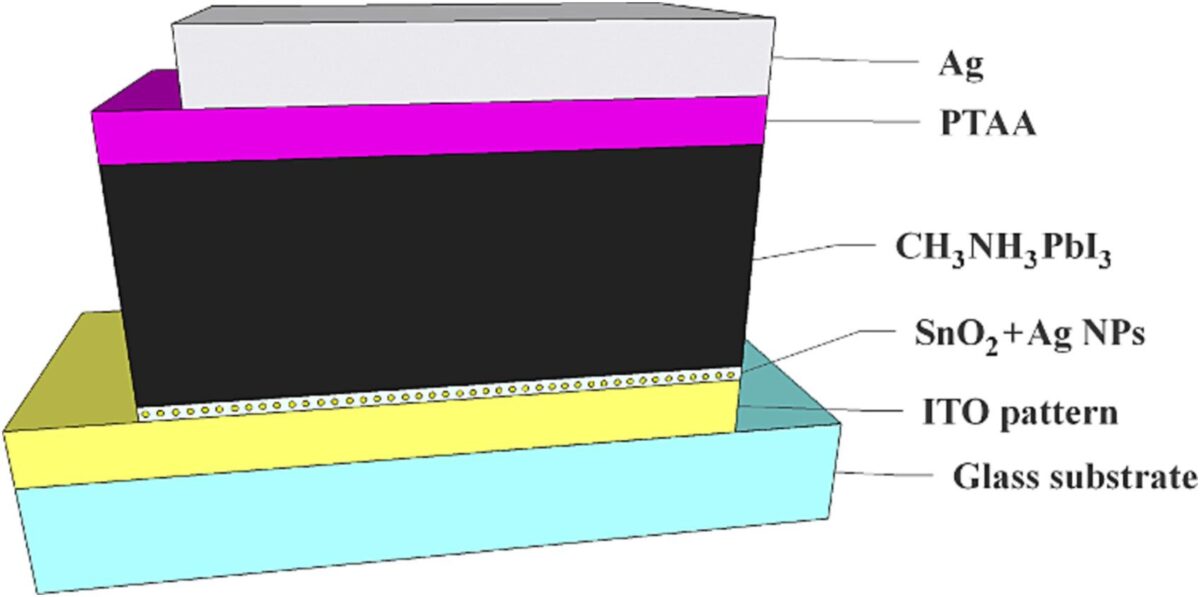A group of researchers led by the University of Sheffield in the United Kingdom has proposed to improve the efficiency of perovskite solar cells by integrating silver (Ag) particles into a cell's electron transport layer (ETL).
Their work considered the utilization of an ETL based on tin(IV) oxide (SnO2), which they claim is the most efficient transport material used in perovskite PV devices. “Ag nanoparticles are synthesized and used to form a SnO2:Ag nanoparticle composite transport layer for the first time,” they added, referring to the novelty of their approach. “Ag is a very suitable material for nanoparticles due to its facile growth in nanostructured forms, its high conductivity at room temperature, its stability, and its plasmonic effect in the visible region of the spectrum.”
They used an approach that is commonly adopted for the development of organic and dye-sensitized PV cells, for which scientists create composite transport layers with metal nanoparticles. In these devices, the nanoparticles act as a sort of antennae that trap the light in their proximity and contribute to exciting electrons into the conduction band in a more efficient way.
The academics tested their approach in a perovskite solar cell constructed with an indium tin oxide (ITO) substrate, an ETL based on SnO2, a perovskite absorber, a hole transport layer (HTL) made of poly-triarylamine (PTAA), and an Ag metal contact, with all the cell layers being deposited in an air process.
The research team deposited Ag nanoparticles with thicknesses of 110 nm on the ETL via chemical synthesis and explained that an alternative process could be depositing thermally evaporated Ag nanoparticles between the ITO substrate and the SnO2 layer. It found, however, that only the first process can increase cell efficiency.
Tested under standard illumination conditions, the cell built with Ag particles deposited via the chemical synthesis process achieved a power conversion efficiency of 14.3%. By way of comparison, a reference cell without Ag nanoparticles reached an efficiency of 13.4%. “These devices are one of the first examples of, and exhibit the highest reported efficiency for, perovskite solar cells fabricated completely in air with nanocomposite oxide layers,” the scientists noted.
Popular content
The group also found the nanoparticles enhanced charge transfer and extraction from the perovskite layer into the electrode, and that this result can be achieved only by defining an “optimal” concentration of nanoparticles. They warned that too high concentrations of Ag could have a negative effect on the cell's recombination rate and short-circuit current.
The details of the manufacturing process are available in the paper “Using Ag nanoparticles in the electron transport layer of perovskite solar cells to improve efficiency,” published in Solar Energy.
“The protocols established here for the synthesis, comparison and integration of composite transport layers have a general validity, and can be applied to perovskite solar cells with different compositions, or to other fields,” the researchers said.
This content is protected by copyright and may not be reused. If you want to cooperate with us and would like to reuse some of our content, please contact: editors@pv-magazine.com.



2 comments
By submitting this form you agree to pv magazine using your data for the purposes of publishing your comment.
Your personal data will only be disclosed or otherwise transmitted to third parties for the purposes of spam filtering or if this is necessary for technical maintenance of the website. Any other transfer to third parties will not take place unless this is justified on the basis of applicable data protection regulations or if pv magazine is legally obliged to do so.
You may revoke this consent at any time with effect for the future, in which case your personal data will be deleted immediately. Otherwise, your data will be deleted if pv magazine has processed your request or the purpose of data storage is fulfilled.
Further information on data privacy can be found in our Data Protection Policy.